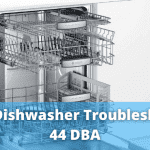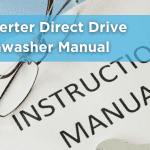Table of Contents
Is your KitchenAid dishwasher not starting? Before dialling a technician, a simple KitchenAid dishwasher reset might be the solution. These straightforward steps could bring your appliance back to life and save you from a potentially costly service call. Here’s a detailed breakdown:
Manual Reset Steps – 1st Method
1. Power Cycle:
- Your dishwasher, like your computer, sometimes needs a quick restart.
- First, disconnect it from the power source. Wait for 5 minutes. This short break can help in resetting minor glitches.
2. Reconnect and Observe:
- After the short wait, plug it back in.
- Examine the display. Are there any flashing lights or unusual messages?
- Give it another 5-10 minutes. Sometimes, it takes a moment to sort itself out.
3. Initiate a Test Run:
- Try a test cycle to see if the dishwasher is back to normal.
- Press the “heat dry”, “normal”, “heat dry”, and “normal” buttons in this sequence. All the panel lights should now be on.
- Press the “start” button.
It will make the dishwasher run a self-test. If it displays an error message, refer to the user guide. It will explain what the error means and might suggest fixes.
Using the Control Panel Reset – 2nd Method
1. Engage Reset Commands:
- If the basic unplugging didn’t do the trick, we can try a more detailed reset.
- Ensure the dishwasher door is firmly shut.
- Press the “hi-temp scrub” and “energy saver dry” buttons. Repeat this five times for each button.
2. Wait and Watch:
- After pressing the buttons, the display might flash, and you could hear the machine make different sounds.
- Allow the dishwasher a 5-10 minute window. It’s recalibrating and diagnosing its functions.
3. Conclude with Draining:
- Hit the “cancel” or “cancel/drain” button to wrap up.
- The dishwasher will now undergo a 2-minute drain cycle. Wait patiently till it finishes.
Other Checks and Tips – 3rd Method
1. Inspect the Control Lock:
- Notice the “lock” indicator light? It could mean the dishwasher controls are locked.
- Press the “lock” button for about 4 seconds to unlock it.
2. Ensure the Door is Latched:
- Sometimes, the problem is as simple as the door needing to be secured.
- Make sure no dish or utensil is blocking it. Push the door firmly till you hear a click indicating it’s locked.
3. Check for Delayed Start:
- Is your dishwasher set to start later? Ensure the “delayed wash” option is deactivated.
- If you find it on, press “cancel/drain” and “start/resume” to get it working instantly.
4. Consider Professional Help:
- After all these steps, if your dishwasher is still unresponsive or quirky, it might be time to consult an expert.
- Always opt for a technician with good reviews. And a pro tip: you can ask if they’d be willing to waive their initial visit fee to make the repair more affordable.
Lastly, always refer to the user manual of your specific KitchenAid dishwasher model. Each model might have slightly different buttons or procedures.
If it Fails to Reset
If the machine does not reset even after activating the power supply, there is a severe problem with the control panel computer board or its fuse burst. Both things can be achieved by removing a door panel. Anyone who has yet to gain this kind of experience should contact a repair service technician.
Cleaning Recipe:
Put 2 cups (500 ml) of white vinegar in a bottle or dishwasher. Take the size of a cup from under the dishwasher. Don’t use detergent in your dishwasher because vinegar dissolves in washing water. Run a dishwasher complete washing cycle using the Air Dry or Energy Saving Dry option. If the clean light keeps blinking, a service error occurs that needs a deep repair, such as water pressure, damaged or broken control board, and possible issues related to the heater or thermostat.
KitchenAid Dishwasher Not Cleaning
If your KitchenAid dishwasher is not cleaning, these are the most frequent causes.
- Water Pump Belt: The water pump belt may be worn or broken. A few dishwashers have a belt, and a few need to. You can explore your model to see if it has a water pump belt. To replace the water pump belt, all you have is to remove the lower panel. You will find a belt at the bottom of the motor. Now replace it If the belt is broken or worn.
- Water Inlet Valve: If there is a blockage or malfunction in the valve, there will not be enough water in the dishwasher to clean the dishes. If there is an obstacle, change it. Please do not try to clean or fix the water inlet valve, as doing so will only worsen it.
- Centre Wash Arm Assembly: If dirty dishes are coming from your dishwasher, there may be an obstruction in the wash arm. To get rid of this clogged problem, Remove the wash arm and remove the debris from its holes. If it is hugely clogged, then replace it with a new one.
Clean KitchenAid Dishwasher Filter
- To remove the dishwasher’s filter, switch the Upper Filter Assembly 1⁄4, turn counterclockwise, and lift it out.
- Hold the lower filter in a circular opening, lift it slightly and push it forward.
- NOTE: Do not use a wire brush, a scouring pad, etc., as the filters can be harmed. Rinse the filter under running water until most soils have been extracted; you might need a soft brush.
- Attach the upper filter assembly to the lower filter circular opening. Rotate this filter in a clockwise direction until it sits in place, and rotate it until it is locked. If you still face any issues, watch this detailed tutorial about how to Clean the KitchenAid Dishwasher Filter.
KitchenAid Dishwasher Not Starting or Not Operating
Is your KitchenAid dishwasher leaking or not draining? Or it’s not getting water. Let’s look at some common issues and how to solve them.
Not Draining
One usual problem with KitchenAid dishwashers is that they need to drain correctly. This can be because it’s not set up right, or stuff like food or grease is blocking the way water goes out.
Checking the Drain Pump
If there’s a lot of water at the bottom of your dishwasher, the drain pump might need to be fixed. Before you check, make sure to turn off and unplug the dishwasher. You’ll have to open the bottom part and look for the pump. If you hear weird noises or see it’s not turning right, it might be the problem.
Not Getting Water
Is your dishwasher turned on but not getting water? First, check your water tap to see if it’s blocked. The pipes or hoses might be dirty or blocked if the tap looks good.
Leaking Problem
Leaking dishwashers are annoying. If your KitchenAid dishwasher is dripping, it might be the water hose. Sometimes, they must be attached right or loose, causing leaks. Make sure they are correctly connected.
No Power or Lights
This can be the first sign there’s an issue. Always check if your dishwasher is plugged in properly. Also, see if a blown fuse or tripped circuit breaker is in your home’s electrical box. Resetting the breaker or replacing the fuse might solve the problem.
Door Latch Problems
Sometimes, the dishwasher will only start if the door is latched securely. Ensure the door is closed tightly and nothing prevents it from shutting. If it still doesn’t work, the latch might be broken and need replacing.
Control Panel Malfunctions
If the buttons don’t respond or show incorrect signals, it’s likely the control panel is at fault. You can reset your dishwasher by unplugging it for 5 minutes and then plugging it back in. If that doesn’t work, you might need professional help.
Water Not Filling
The water supply might be turned off if water isn’t entering the machine. Check the water valve under your sink to ensure it’s open. The issue could be a clogged or kinked water supply hose.
Spray Arm Blockage
The spray arm circulates water in the dishwasher. If dishes aren’t getting clean, they might be blocked. Check for food particles or other debris and clear them away. Rotate the arm with your hand to ensure it moves freely.
Detergent Dispenser Problems
If the detergent isn’t being released, ensure the dispenser isn’t clogged. Clean it with a soft brush and warm water. Also, ensure you’re using the recommended detergent for your dishwasher.
Unusual Noises
Dishwashers make some noise, but loud or strange sounds aren’t normal. Check if a dish or utensil isn’t rattling around. If everything seems in order, but the noise persists, there might be an internal issue, and you should contact a technician.
Cycle Not Advancing
If the dishwasher seems stuck on one cycle, it could be a timer or control panel issue. Try resetting the dishwasher. If that doesn’t help, a technician might be needed to address the problem.
KitchenAid Dishwasher Installation
If you install your dishwasher for the first time or change the old dishwasher, you can do it yourself. To do this, you will need an Electrician and plumbing tools. Let me summarize it in a few steps!
THINGS YOU’LL NEED

Installation Steps
These are a few simple steps to install your KitchenAid Dishwasher.
- Step 1: First of all, install a New Hot Water Shutoff Valve.
- Step 2: Drill holes for drain hose and power cord.
- Step 3: Prepare the Sink Drain.
- Step 4: Install an Air Gap If You Need One.
- Step 5: Prepare the Dishwasher.
- Step 6: Move the Dishwasher into Position.
- Step 7: Connect the Drain Hose.
- Step 8: Hook Up the Water.
- Step 9: Connect the Power.
Check out this PDF detailed guide and video tutorial to install a dishwasher.
LEVELING
Dishwashers need a level surface to wash enough and prevent leakage. A dishwasher should have four mounting legs, and the rear wheels should stick to the ground. Some models have four fitting legs inside. The dishwasher cabinet should be square because the door will only be adequately sealed if the tub’s opening is fair. This is the responsibility of the customer or the installer. This video will help you to level your dishwasher correctly.
Load
Loading the dishwasher is the first step in using the equipment properly. If there is a problem closing the dishwasher door properly, it won’t turn on. You may need to rearrange your serving dishes or load fewer dishes. Let us introduce some tips and tricks for loading a dishwasher correctly.
- Some water may remain under the concave cup and mug, so it is necessary to load items at an angle, especially for the plastic item.
- Plastic items can take longer to dry, and it might not be dry totally in a regular cycle.
- Use the upper rack for bowls & cups, and use the lower rack for plates, utensils, and cups.
- Please make sure all the plates are slotted in a rack on their side, and all cups are facing-down.




